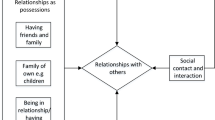The Satisfaction with Life Scale: Philosophical Foundation and Practical Limitations

Research and policymaking on positive mental health and well-being have increased within the last decade, partly fueled by decreasing levels of well-being in the general population and among at-risk groups. However, measurement of well-being often takes place in the absence of reflection on the underlying theoretical conceptualization of well-being. This disguises the fact that different rating scales of well-being often measure very different phenomena because rating scales are based on different philosophical assumptions, which represent radically different foundational views about the nature of well-being. The aim of this paper is to examine the philosophical foundation of the Satisfaction with Life Scale (SWLS) in order to clarify the underlying normative commitments and the psychometric compromises involved in the translation of theory into practice. SWLS is widely used by psychologists, public health professionals, economists, and is popular in national and international surveys of well-being. This paper introduces the philosophical theory of life satisfaction and explores how three central discussions within life satisfaction theory are reflected in the construction of the SWLS; (1) Whether we should be equally satisfied with our past, present and future, (2) Whether we should be satisfied with all the various domains of our lives, and (3) How to avoid the trap of “false consciousness”, i.e. that people fail to recognize the injustice or misfortune of their lives. In the end, life satisfaction theory is contrasted with affective foundational theories of well-being, to explore the magnitude and limits of SWLS as a rating scale based on life satisfaction theory.
This is a preview of subscription content, log in via an institution to check access.
Access this article
Subscribe and save
Springer+ Basic
€32.70 /Month
- Get 10 units per month
- Download Article/Chapter or eBook
- 1 Unit = 1 Article or 1 Chapter
- Cancel anytime
Buy Now
Price includes VAT (France)
Instant access to the full article PDF.
Rent this article via DeepDyve
Similar content being viewed by others
The fundamental association between mental health and life satisfaction: results from successive waves of a Canadian national survey
Article Open access 12 March 2018

Bringing Life to Mind: A Qualitative and Quantitative Approach to Identifying the Information Used in Life Satisfaction Judgements
Article 26 July 2018

Introduction: Looking at Quality of Life and Well-Being from a Positive Psychology Perspective
Chapter © 2013
References
- Landes, X. (2015). Building happiness indicators some philosophical and political issues. Les ateliers de l’éthique,10(2), 4–37. https://doi.org/10.7202/1035325ar. ArticleGoogle Scholar
- Tiberius, V. (2006). Well-being: Psychological research for philosophers. Philosophy Compass,1(5), 493–505. ArticleGoogle Scholar
- Cooke, P. J., Melchert, T. P., & Connor, K. (2016). Measuring well-being: A review of instruments. The Counseling Psychologist,44(5), 730–757. https://doi.org/10.1177/0011000016633507. ArticleGoogle Scholar
- de Boer, J. (2014). Scaling happiness. Philosophical Psychology,27(5), 703–718. https://doi.org/10.1080/09515089.2013.792715. ArticleGoogle Scholar
- Haro, J. M., Ayuso-Mateos, J. L., Bitter, I., Demotes-Mainard, J., Leboyer, M., Lewis, S. W., et al. (2014). ROAMER: roadmap for mental health research in Europe. International Journal of Methods in Psychiatric Research,23(S1), 1–14. https://doi.org/10.1002/mpr.1406. ArticlePubMedGoogle Scholar
- Kusier, A. O., & Folker, A. P. (2019). The Well-Being Index WHO-5: Hedonistic foundation and practical limitations. Medical humanities,46(3), 333–339. https://doi.org/10.1136/medhum-2018-011636. ArticlePubMedGoogle Scholar
- Angner, E. (2010). Subjective well-being. The Journal of Socio-Economics,39(3), 361–368. https://doi.org/10.1016/j.socec.2009.12.001. ArticleGoogle Scholar
- Diener, E., & Suh, E. (1997). Measuring quality of life: Economic, social, and subjective indicators. Social Indicators Research,40(1), 189–216. https://doi.org/10.1023/a:1006859511756. ArticleGoogle Scholar
- Deci, E. L., & Ryan, R. M. (2008). Hedonia, eudaimonia, and well-being: an introduction. Journal of Happiness Studies,9(1), 1–11. https://doi.org/10.1007/s10902-006-9018-1. ArticleGoogle Scholar
- McDowell, I. (2010). Measures of self-perceived well-being. Journal of Psychosomatic Research,69(1), 69–79. ArticleGoogle Scholar
- Crisp, R. (2017). Well-being. In: E. N. Zalta (Ed.), The stanford Encyclopedia of Philosophy.
- Feldman, F. (2012). What is this thing called happiness? New York: Oxford University Press Inc. Google Scholar
- Haybron, D. M. (2008). The pusuit of unhappiness: The elusive psychology of well-being. Oxford: Oxford University Press. Google Scholar
- Kagan, S. (1998). Normative ethics. New York: Routledge. Google Scholar
- Biswas-Diener, R., Kashdan, T. B., & King, L. A. (2009). Two traditions of happiness research, not two distinct types of happiness. The Journal of Positive Psychology,4(3), 208–211. https://doi.org/10.1080/17439760902844400. ArticleGoogle Scholar
- Huta, V., & Waterman, A. S. (2014). Eudaimonia and Its distinction from hedonia: Developing a classification and terminology for understanding conceptual and operational definitions. Journal of Happiness Studies,15(6), 1425–1456. https://doi.org/10.1007/s10902-013-9485-0. ArticleGoogle Scholar
- Helliwell, J., Layard, R., & Sachs, J. (2017). World happiness report 2017. New York: Sustainable Development Solutions Network. Google Scholar
- Helliwell, J., Richard, L., Jeffrey, S., & Jan-Emmanuel, D. (2020). World happiness report 2020. New York: Sustainable Development Solutions Network. Google Scholar
- World Health Organization Regional Office for Europe (2012). Measurement of and target-setting for well-being: an initiative by the WHO Regional Office for Europe.
- Pavot, W., & Diener, E. (2009). Review of the satisfaction with life scale. In: Assessing well-being (pp. 101–117): Springer.
- Haybron, D. M. (2011). Happiness. In: Z. N. Edward (Ed.), The stanford encyclopedia of philosophy.
- Diener, E., Inglehart, R., & Tay, L. (2013). Theory and validity of life satisfaction scales. Social Indicators Research,112(3), 497–527. https://doi.org/10.1007/s11205-012-0076-y. ArticleGoogle Scholar
- Diener, E., Emmons, R. A., Larsen, R. J., & Griffin, S. (1985). The satisfaction with life scale. Journal of Personality Assessment,49(1), 71–75. ArticleCASGoogle Scholar
- Dierne, E. (2019). Satisfaction with life scale (SWLS). UK: Psychology Press. Google Scholar
- Whisman, M. A., & Judd, C. M. (2016). A cross-national analysis of measurement invariance of the satisfaction with life scale. Psychological Assessment,28(2), 239. ArticleGoogle Scholar
- Kobau, R., Sniezek, J., Zack, M. M., Lucas, R. E., & Burns, A. (2010). Well-being assessment: An evaluation of well-being scales for public health and population estimates of well-being among US adults. Applied Psychology: Health and Well-Being,2(3), 272–297. Google Scholar
- Cohen, A. B., Pierce, J. D., Chambers, J., Meade, R., Gorvine, B. J., & Koenig, H. G. (2005). Intrinsic and extrinsic religiosity, belief in the afterlife, death anxiety, and life satisfaction in young catholics and protestants. Journal of Research in Personality,39(3), 307–324. https://doi.org/10.1016/j.jrp.2004.02.005. ArticleGoogle Scholar
- Mosher-Ashley, P., & Rabon, C. E. (2001). A comparison of older and younger adults attending alcoholics anonymous. Clinical Gerontologist,24(1–2), 27–37. ArticleGoogle Scholar
- Heisel, M. J., & Flett, G. L. (2004). Purpose in life, satisfaction with life, and suicide ideation in a clinical sample. Journal of Psychopathology and Behavioral Assessment,26(2), 127–135. https://doi.org/10.1023/B:JOBA.0000013660.22413.e0. ArticleGoogle Scholar
- Fife, J., Adegoke, A., McCoy, J., & Brewer, T. (2011). Religious commitment, social support and life satisfaction among college students. College Student Journal,45(2), 393–400. Google Scholar
- Arrindell, W. A., Heesink, J., & Feij, J. A. (1999). The satisfaction with life scale (SWLS): Appraisal with 1700 healthy young adults in the Netherlands. Personality and Individual Differences,26(5), 815–826. https://doi.org/10.1016/S0191-8869(98)00180-9. ArticleGoogle Scholar
- Glaesmer, H., Grande, G., Braehler, E., & Roth, M. (2011). The German version of the satisfaction with life scale (SWLS). European Journal of Psychological Assessment.,27(2), 127–132. ArticleGoogle Scholar
- Abdallah, T. (1998). The satisfaction with life scale (SWLS): Psychometric properties in an Arabic-speaking sample. International Journal of Adolescence and Youth,7(2), 113–119. https://doi.org/10.1080/02673843.1998.9747816. ArticleGoogle Scholar
- Pavot, W., & Diener, E. (2008). The satisfaction with life scale and the emerging construct of life satisfaction. The Journal of Positive Psychology,3(2), 137–152. ArticleGoogle Scholar
- Sumner, L. W. (1996). Welfare happiness & ethics. United States: Oxford University Press Inc., New York. Google Scholar
- Feldman, F. (2004). Pleasure and the good life: Concerning the nature varieties and plausibility of hedonism. Oxford: Oxford University Press. BookGoogle Scholar
- Tatarkiewicz, W. (1966). Happiness and time. Philosophy and Phenomenological Research,27(1), 1–10. ArticleGoogle Scholar
- Wilson, T. D., & Gilbert, D. T. (2005). Affective forecasting: Knowing what to want. Current Directions in Psychological Science,14(3), 131–134. https://doi.org/10.1111/j.0963-7214.2005.00355.x. ArticleGoogle Scholar
- Kahneman, D. (1999). Objective happiness. Well-being: The foundations of hedonic psychology,3(25), 1–23. Google Scholar
- McIntosh, C. N. (2001). Report on the construct validity of the temporal satisfaction with life scale. Social Indicators Research,54(1), 37–56. ArticleGoogle Scholar
- Karniol, R., & Ross, M. (1996). The motivational impact of temporal focus: Thinking about the future and the past. Annual review of psychology,47(1), 593–620. ArticleCASGoogle Scholar
- Pavot, W., Diener, E., & Suh, E. (1998). The temporal satisfaction with life scale. Journal of Personality Assessment,70(2), 340–354. https://doi.org/10.1207/s15327752jpa7002_11. ArticleGoogle Scholar
- Pavot, W. (2014). Temporal satisfaction with life scale (TSWLS). In A. C. Michalos (Ed.), Encyclopedia of quality of life and well-being research (pp. 6609–6611). Dordrecht: Springer, Netherlands. ChapterGoogle Scholar
- Oishi, S. (2006). The concept of life satisfaction across cultures: An IRT analysis. Journal of Research in Personality,40(4), 411–423. https://doi.org/10.1016/j.jrp.2005.02.002. ArticleGoogle Scholar
- Alexandrova, A. (2017). The science of Well-being. In: G. Fletcher (Ed.), The Routledge Handbook of Philosophy of Well-being: Routledge.
- Haybron, D. M. (2011). Taking the satisfaction (and the life) out of life satisfaction. Philosophical Explorations,14(3), 249–262. ArticleGoogle Scholar
- Topp, C. W., Østergaard, S. D., Søndergaard, S., & Bech, P. (2015). The WHO-5 well-being index: A systematic review of the literature. Psychotherapy and Psychosomatics,84(3), 167–176. ArticleGoogle Scholar
- Haybron, D. M. (2013). Happiness: A very short introduction. Oxford: Oxford University Press. BookGoogle Scholar
- Kettlewell, N., Morris, R. W., Ho, N., Cobb-Clark, D. A., Cripps, S., & Glozier, N. (2020). The differential impact of major life events on cognitive and affective wellbeing. SSM-Population Health,10, 100533. https://doi.org/10.1016/j.ssmph.2019.100533. ArticlePubMedGoogle Scholar
Funding
The authors have not declared a specific grant for this research from any funding agency in the public, commercial or not-for-profit sectors.
Author information
Authors and Affiliations
- The Research Department for Health and Social Context, National Institute of Public Health, University of Southern Denmark, Studiestraede 6, 1455, Copenhagen K, Denmark Amalie Oxholm Kusier & Anna Paldam Folker
- Amalie Oxholm Kusier


